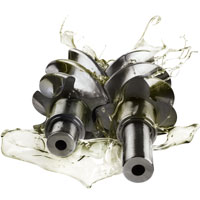Synthetic lubricants for tomorrow’s refrigeration
- Like
- Digg
- Del
- Tumblr
- VKontakte
- Buffer
- Love This
- Odnoklassniki
- Meneame
- Blogger
- Amazon
- Yahoo Mail
- Gmail
- AOL
- Newsvine
- HackerNews
- Evernote
- MySpace
- Mail.ru
- Viadeo
- Line
- Comments
- Yummly
- SMS
- Viber
- Telegram
- Subscribe
- Skype
- Facebook Messenger
- Kakao
- LiveJournal
- Yammer
- Edgar
- Fintel
- Mix
- Instapaper
- Copy Link
Posted: 4 August 2014 | ExxonMobil | No comments yet
ExxonMobil’s solutions for the evolving refrigeration market…


The importance of refrigeration to address the global food supply, health needs and the demands of the automotive industry has never been greater. Environmental considerations, supported by Montreal and Kyoto protocols, are driving change in refrigerant technologies, which subsequently has an impact on lubricant selection. ExxonMobil’s Gilles Delafargue, Field Engineering Support Advisor, Europe, Africa & Middle East, looks into how synthetic lubricants respond to the changes and trends in today’s refrigeration and help improve energy efficiency of refrigeration systems.
Evolution of the market
The Montreal Protocol (1989) addressed the phase-out of substances with high Ozone Depleting Potential (ODP) and has impacted ChloroFluoroCarbons (CFCs) refrigerants (now forbidden) and HydroChloroFluoroCarbons (HCFCs) – now in cancellation phase. The Kyoto Protocol (1997) established commitments for the reduction of greenhouse gases. It is likely to impact some ozone-friendly HydroFluoroCarbons (HFCs) refrigerants as some of them have high Global Warming Potential (GWP), and drive the use of HydroFluoroOlefins (HFOs). Together, these protocols indirectly promoted the re-birth of ammonia (0 ODP/0 GWP) and carbon dioxide CO2 (low ODP/GWP) as refrigerant options.


The environmental legislation has created a growing trend towards natural refrigerants, such as ammonia, CO2 and, to some extent, Hydrocarbons (HCs).HCs are likely to stay in domestic appliances, but advocates of HCs are continuing to promote their use in larger equipment, with commercial ice machines as well as reach-in/walk-in freezers and coolers possibly next in line1. HFCs still have an important presence, however their replacement with Low ODP/Low GWP HFOs is expected to grow. Both CO2 and HFO-1234yf are being promoted in Europe for car air conditioning systems2. In 2012, one of the world’s biggest drinks companies announced that it will have completed phasing out the use of HFCs in new equipment by 20153. We have also started to seeHFC-free supermarkets4.
Miscibility and viscosity for proper lubrication


The lubricant’s miscibility with the refrigerant at the evaporator temperature is crucial in miscible applications (systems not equipped with oil separators). The refrigerant fluid/lubricant blend must not separate after expansion in the evaporator to travel through to the compressor. If they separate due to inappropriate miscibility, fluid is likely to get trapped in the evaporator and seriously affect the efficiency of the refrigeration unit or the smooth running of the compressor.
At compressor level, both high pressure and temperature will cause a decrease in oil viscosity (linked to the solubility of the refrigerant in the lubricant), which would affect wear protection if viscosity at application was not high enough. The effects of the viscosity decrease can be mitigated by selection of the appropriate lubricant technology and viscosity. ExxonMobil provides a full set of miscibility curves and VPT (Viscosity/Pressure/Temperature) curves to ensure that the lubricant selected matches miscibility and viscosity requirements for the application. Customers also benefit from technical assistance via a team of field experts or via the ExxonMobil Technical Helpdesk.
Wide range of “cool” products
ExxonMobil has been closely following the changes in legislation and endeavoured to respondto the environmental requirements with high-performance products for ammonia, HFO and CO2 applications. Mobil EAL (Environmental Awareness Lubricants) Arctic series synthetic lubricants are designed specifically for refrigeration compressors and systems using HFC refrigerants. They are formulated from proprietary synthesized Polyol Esters (POEs)to provide outstanding lubricity, wear protection, chemical and thermal stability. Mobil EAL Arctic lubricants are adequately miscible withHFC refrigerants and have well-defined viscosity/temperature/pressure relationships with a wide range of HFCs.
Large refrigerant systemsusing ammonia (non- or low-miscible with HCs) as a refrigerant are equipped with oil separators so it is desirable to use a lubricant that is quite immiscible with the refrigerant fluid, and has low vapour pressure to avoid or minimize oil carry over in circuit. Mobil Gargoyle Arctic SHC 200 series, PolyAlphaOlefins (PAO) – based lubricants, are recommended for the lubrication of refrigeration compressors operating at very high temperatures, and for systems with very low evaporator temperatures. Their solubility and miscibility with commonly used refrigerants is low, resulting in higher film thicknesses in the presence of refrigerants under pressure which can reduce shaft seal leakage. With their naturally high shear stable viscosity indexes and low temperature fluidity they are able to perform efficiently in severe service conditions with ammonia as the refrigerant. Mobil Gargoyle Arctic SHC 200 is also suitable for CO2 non- or low-miscible applications. In addition, the Mobil Gargoyle Arctic SHC 200 Series is NSF H-1 registered and is consequently suitable for incidental food contact.
Improving efficiency
Many compression refrigeration units today are using ammonia as a refrigerant fluid. The main lubricant technologies for ammonia applications are:
- Mineral Naphthenic (MN) and Mineral Paraffinic (MP) lubricants, refined from naphthenic and paraffinic crude oils;
- PolyAlphaOlefin (PAO)-based and Blended PAO/AB (Alkyl Benzene) synthetic oils.
The extensive set of tests carried out at ExxonMobil Research & Engineering centre (EMRE) in 2011 showed PAOas the potentially best technology for ammonia versus MN and MP (significant room for plant efficiency improvement, best low temperature characteristics, lowest oil carry over, excellent viscosity control at high temperature, best degassing characteristics). Mobil Gargoyle Arctic SHC™ 200 series lubricants – wax-free PAO lubricants for non-miscible applications – provide outstanding lubrication for compressors in industrial, commercial, and heat pump refrigeration systems, and have been particularly successful in systems using ammonia. Furthermore, the viscosity at low temperatures of ExxonMobil’s PAO-based lubricants, significantly lower than standard Mineral Naphthenic or Mineral Paraffinic lubricants, makes it possible to improve plant efficiency by minimizing insulating oil layer affecting thermal exchanges and, consequently, energy efficiency, when the lubricant is trapped at evaporator level*5.
They benefit from excellent thermal, oxidative and chemical stability, which means potentially longer oil life and reduced maintenance costs, increased drain intervals, longer filter life and reduced shaft-seal leakage compared to standard mineral oils. Mobil Gargoyle Arctic SHC 226E has helped save a major brewery in Poland up to $140,000 in three years. Following a switch from a mineral lubricant, the oil drain intervals have extended by six times (from twice a year to every three years) resulting in reduced drain and separator costs as well as waste oil, reduced deposit formation and lower compressor maintenance costs.
Future for cold
Alternative technologies such as “Magnetic cold” have started to appear on the market and move towards the mainstream. Highly energy-efficient magnetic cold provides cooling by using the temperature change from adding and subtracting a magnetic field, without the need for refrigerants or expensive compressors. Recently two European firms have announced plans for commercial and domestic launches of products based on magnetic refrigeration within the next two years6, and some specialists say that magnetic refrigeration can cover 80 per cent of the vapour compressor market today7. However the classic compression units, together with the evolution towards Low ODP/Low GWP refrigerant fluids, are expected to stay for a while in the market. ExxonMobil’s full range of products covers the needs of the evolving market, and its offer has been particularly strong for applications using ammonia.
Conclusion
It takes suitable maintenance to operate an industrial refrigeration system. Interruption of service or reduced system capacity can result in significant loss of production or products in storage. With the growing trend towards natural refrigerants (ammonia, CO2 and HCs) or the gradual replacement of HFCs with Low ODP/Low GWP HFOs, the availability of high-performance lubricants to meet environmental requirements has never been more significant. ExxonMobil has endeavoured to respond to these demands and trends with a wide range of globally available products and continues to develop its portfolio to meet the challenges of tomorrow, while providing guidelines and expert technical assistance to customers.
*Compared to standard Mineral Naphthenic or Mineral Paraffinic lubricants
References
- ‘Refrigeration trends towards natural refrigerants’, P. Powell, July 2013, http://www.achrnews.com/articles/120384-refrigeration-trends-toward-natural-refrigerants
- The Ebb and Flow of CO2 and HFO-1234yf in Stationary and Transit Applications, Peter Powell, April 2013, http://www.achrnews.com/articles/123070-the-ebb-and-flow-of-co2-and-hfo-1234yf-in-stationary-and-transit-applications
- ‘Coca-Cola Co. said it will begin phasing out the use of HFCs in new equipment and complete that process by 2015’ http://www.achrnews.com/articles/120384-refrigeration-trends-toward-natural-refrigerants
- ‘Awaiting the Natural Refrigerant Revolution’, P. Powell, April 2013, http://www.achrnews.com/blogs/17-opinions/post/122990-awaiting-the-natural-refrigerant-revolution
- Based on ‘Oil, just for lubrication!’, Titus M.C. Bartholomeus, Senior Development Engineer, Grasso Products b.v. www.grasso-global.com
- Commercial & domestic magnetic refrigeration launches imminent’, Andrew Gaved, Refrigeration and Air Conditioning Magazine, June 2013, http://www.racplus.com/news/commercial-and-domestic-magnetic-refrigeration-launches-imminent/8649939.article
- Cooltech research and development director Tim Lorkin cited in the article referenced above,http://www.racplus.com/news/commercial-and-domestic-magnetic-refrigeration-launches-imminent/8649939.article




